The Adolph A. Weinman design was chosen in 1916 to replace the Barber design, which had been used since 1892, as the new half-dollar motif. Sculptor Weinman also created the same year’s Liberty Head or “Mercury” dime.
What Is the 1939 Liberty Half Dollar Made Of?
The 1939 Walking Liberty half-dollar contains 90% Silver and 10% Copper. The 30.00-millimeter coin has a reeded edge and weighs 12.50 grams.
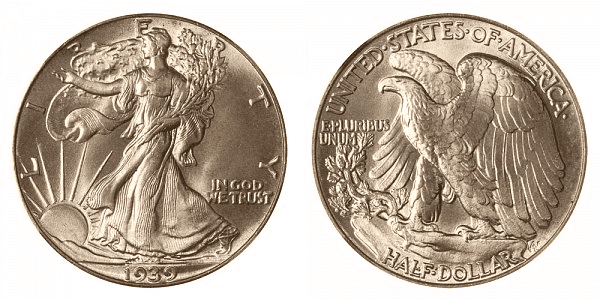
Lady Liberty is shown on the coin’s obverse, walking toward the sun with her right arm extended. Her left arm is holding a bundle of branches while a starry cape trails behind her. The word LIBERTY overarches above, and the famous adage IN GOD WE TRUST is placed behind her. Below, you will find the year of minting 1939.
On the reverse, a bald eagle is depicted sitting atop a rocky outcrop, from which a pine sapling, a symbol of strength, grows. E PLURIBUS UNUM is placed on the left, just above the branches.
UNITED STATES OF AMERICA overarches above the coin’s rim while the denomination is below. The “D” or “S” mint mark is beneath the pine sapling for the coins struck in Denver and San Francisco. Philadelphia did not include any mint marks on its coins.
1939 Liberty Half Dollar Varieties
Here are the Liberty half dollar varieties minted in 1939:
| Variety | Mint Location | Mintage |
| 1939 D Liberty Half Dollar | Denver | 4,267,800 |
| 1939 S Liberty Half Dollar | San Francisco | 2,552,000 |
| 1939 P Liberty Half Dollar | Philadelphia | 6,812,000 |
| 1939 Proof Liberty Half Dollar | Philadelphia | 8,808 |
| Total | 13,640,608 |
1939 D Liberty Half Dollar
Year of minting: 1939
Mint Mark: D
Place of minting: Denver
Quantity produced: 4,267,800
Face Value: $0.50 (half dollar)
Price: $15 to $27 (circulated condition)
Mass: 12.50 grams
Edge: Reeded
Designer: Adolph Alexander Weinman
Composition: 90% silver and 10% copper
Diameter: 30.00 millimeters
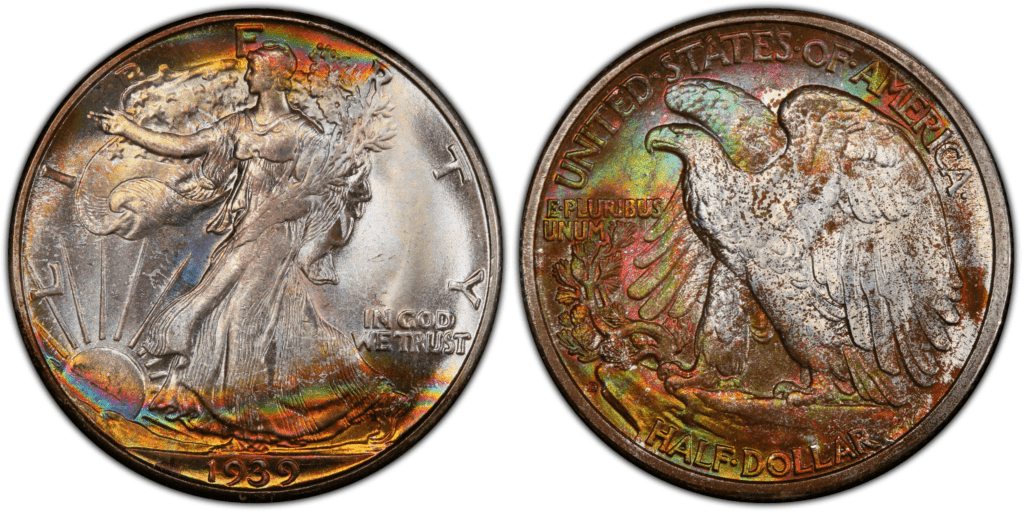
Nearly ten times as many half dollars were produced in 1939 at the Denver Mint as in 1938. Even though it took until 1941 for the country to fully recover from the Great Depression, things had undoubtedly improved since the lean years of 1937–1938.
The 1939 D Liberty half dollar is typically well-struck, just like most Denver Mint coins from the late 1930s into the 1940s. There are plenty of gems up to MS-66, and there are enough MS-67 pieces to please more seasoned collectors.`
Under its VarietyPlus Service, NGC recognizes two beautiful repunched mintmark variations. Bruce Fox’s book illustrates a third, but this is a simple strike doubling. The functional hub doubling seen on 1939-dated halves of all three mints is most likely the DDO variation identified for 1939 D Liberty half dollars.
The Denver Mint Walker from the 1930s that is most widely available is the 1939 D Walking Liberty half dollar. The 1939 D is slightly less common than 1939 in exceptional gem MS66 or better form, but it is still not all that uncommon compared to 1939 in uncirculated condition. This issue contains a lot of really glossy white gems.
The strike on Lady Liberty’s left thumb is occasionally very light and moderately sharp.
A 1939 Walking Liberty half dollar in circulated condition is worth between $11.75 and $50 (NGC Price Guide, January 2023). If sold on the open market, the 1939 D half dollar can fetch up to $10000 if it is in pristine and uncirculated condition.
1939 S Liberty Half Dollar
Year of minting: 1939
Mint Mark: S
Place of minting: San Francisco
Quantity produced: 2,552,000
Face Value: $0.50 (half dollar)
Price: $15 to $87 (circulated condition)
Mass: 12.50 grams
Edge: Reeded
Designer: Adolph Alexander Weinman
Composition: 90% silver and 10% copper
Diameter: 30.00 millimeters
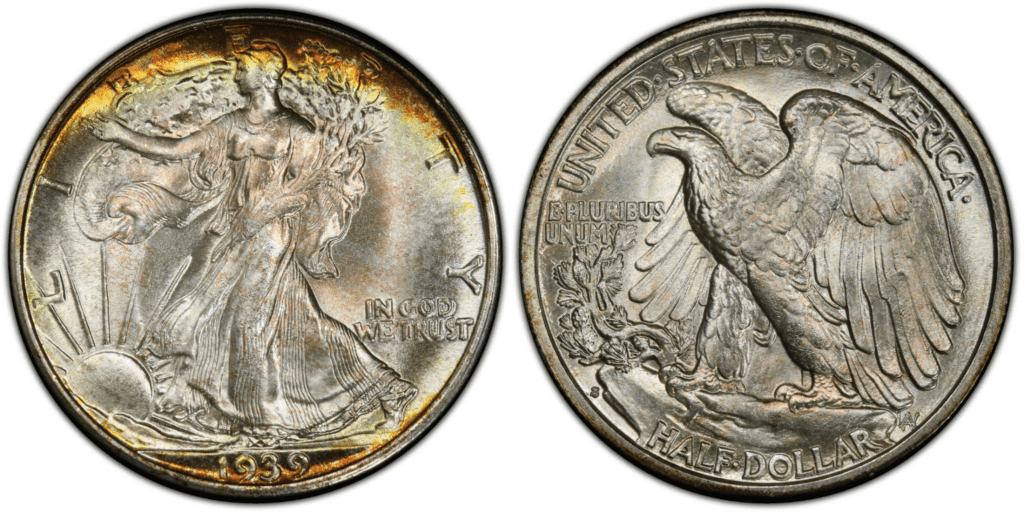
The San Francisco Mint had stopped producing circulating half dollars in 1937, and when it did so again in 1939, the output was roughly equal to that of 1937-S. For this date, well struck gems can be found, and many specimens are grading up to MS-66. The MS-67 grade has fewer verified pieces, but there are still enough to satisfy more seasoned collectors.
Given how similar the DDO variety for this date is to those of 1939(P) and 1939-D, it is most likely a working hub doubling that was later transferred to working dies for all three mints.
The 1939 S Walking Liberty half dollar is the most widely available among the San Francisco Mint Walking Liberty half dollars from the 1930s. However, among the three 1939 editions, it is the rarest. There are a lot of frosty white, highly lustrous gems on this issue, and the strike is decent for an S-mint.
In circulated conditions, the Walking Liberty half dollar is worth between $11.75 and $135 (NGC Price Guide). As of writing, the value of these half dollars in pristine, uncirculated condition can get up to $14,250 on the open market.
1939 P Liberty Half Dollar
Year of minting: 1939
Mint Mark: no mint mark
Place of minting: Philadelphia
Quantity produced: 6,812,000
Face Value: $0.50 (half dollar)
Price: $15 to $29 (circulated condition)
Mass: 12.50 grams
Edge: Reeded
Designer: Adolph Alexander Weinman
Composition: 90% silver and 10% copper
Diameter: 30.00 millimeters
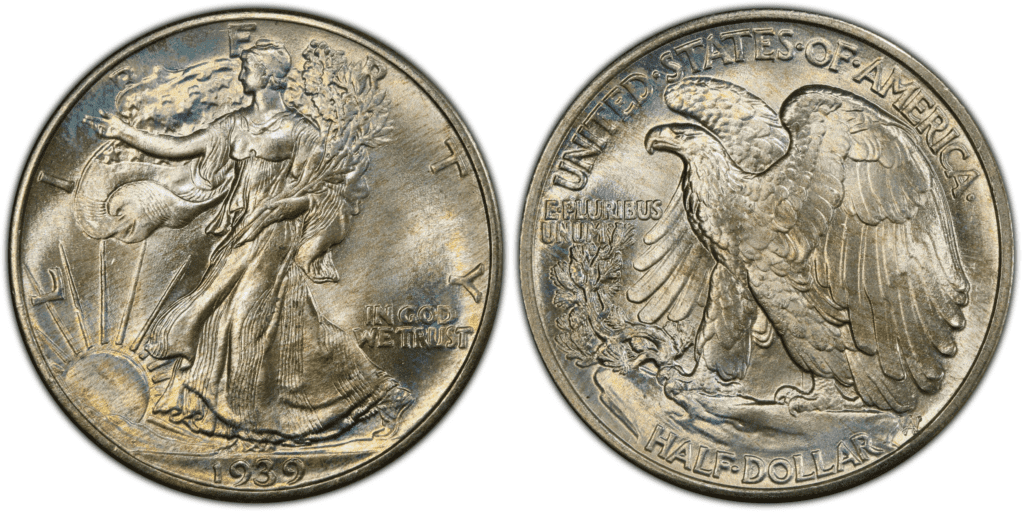
The Philadelphia Mint produced 50% more half dollars in 1939 than in 1938, a sign of recovering economic activity after the terrible depression of 1937–1938. This issue is plentiful throughout the MS-67 grade. A fine doubled-die obverse variant is known for the 1939 P Walking Liberty half dollars, attributed by NGC under its VarietyPlus Service.
Of all the Walking Liberty half dollars from the 1930s, the 1939 series is the most widely available. In the past, it was offered on an uncirculated roll, and numerous outstanding gem examples are in circulation. However, compared to the Philadelphia issues from the 1940s, this issue is rarer.
Roll saving was in full swing in the 1940s, even though mintages for issues from that decade had significantly higher prices, and there was undoubtedly coin saving in 1939. The typical 1939 Walking Liberty half dollar is very well struck. Numerous iridescent gems have a mild golden undertone and a frosty white luster.
According to the NGC Price Guide on their website, a Walking Liberty half dollar from 1939 in circulated condition is worth between $11.75 and $50. These coins could sell for as much as $15,000 on the open market if uncirculated and pristine.
1939 Proof Liberty Half Dollar
Year of minting: 1939
Mint Mark: no mint mark
Place of minting: Philadelphia
Quantity produced: 8,808
Face Value: $0.50 (half dollar)
Price: $114 to $230 (circulated condition)
Mass: 12.50 grams
Edge: Reeded
Designer: Adolph Alexander Weinman
Composition: 90% silver and 10% copper
Diameter: 30.00 millimeters
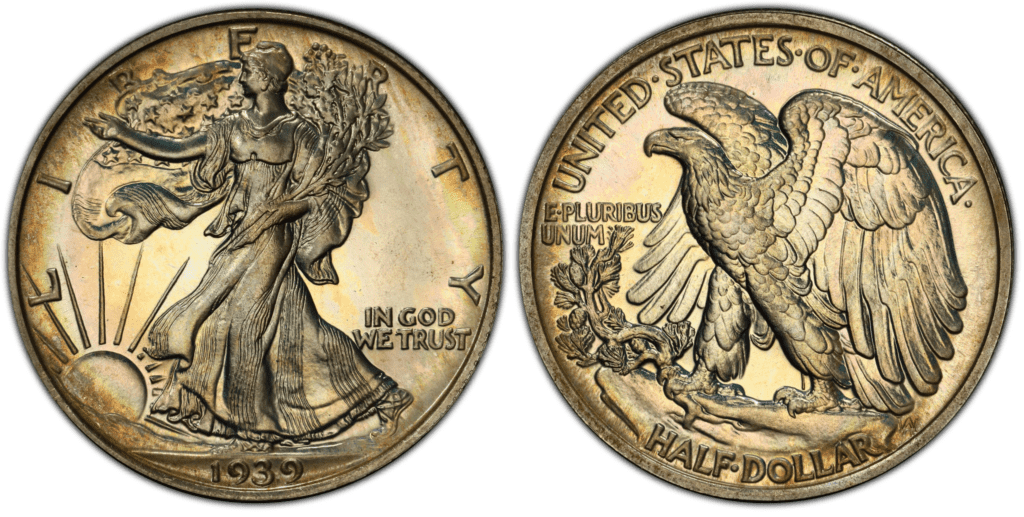
The 1939 is much easier to find than the 1938 Liberty coins, especially in Gem grades. This particular set has a slightly higher mintage (8,808 to 8,152) than the 1938-proof Walking Liberty half dollars. It is also frequently found in Superb condition, indicating that more were carefully conserved and saved.
Most 1939 Walking Liberty half dollar proofs, notably those showing the sun, have little to no cameo contrast.
List Of 1939 Liberty Half Dollar Errors
Repunched Mint Mark (RPM)
When the letter punch used to place the mintmark into the working die leaves two or more offset imprints, the result is a repunched mintmark variant. Nearly invariably, the impressions cross over. A completely separate secondary mintmark is exceptionally rare.
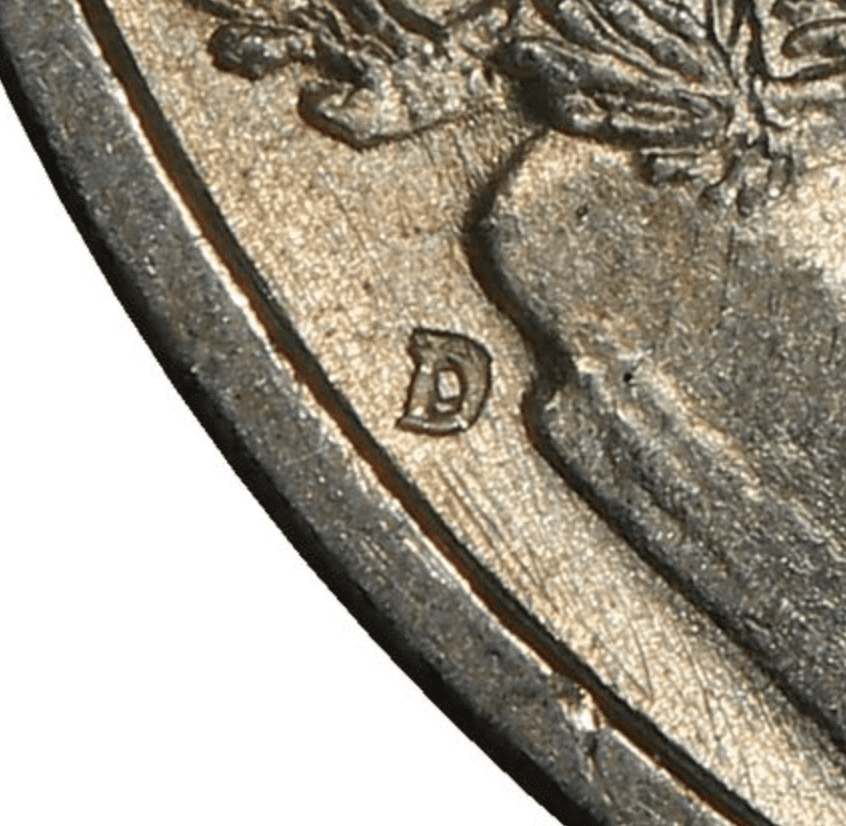
Struck Over Error
When a foreign material or object gets onto a die or blank and imprints the coin, it causes a strikethrough or a struck-over error. Sometimes the die is sticky or oily, which weakens the impression.
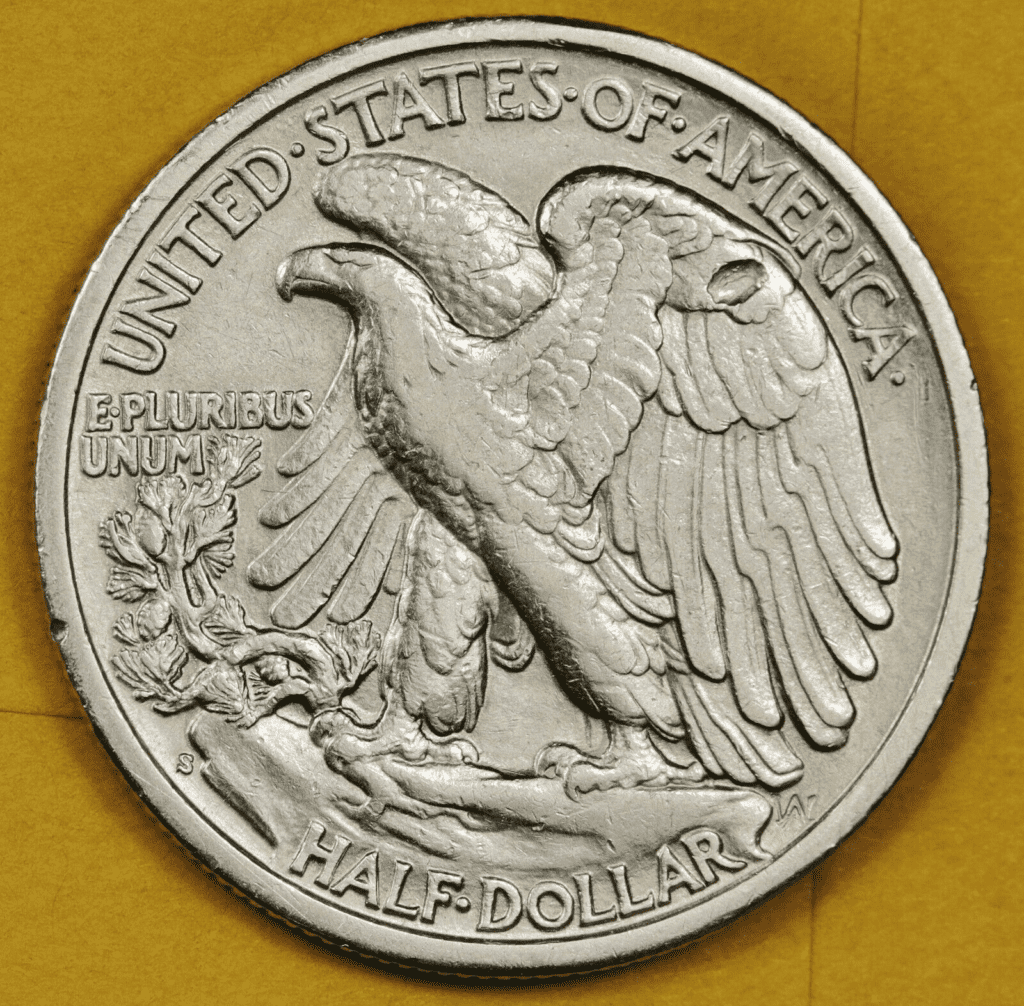
How Much Is the 1939 Liberty Half Dollar Worth Today?
The NGC estimates the melt value of the 1939 Walking Liberty half-dollar at $8.69 as of early 2023. Its face value is $0.50 or half a dollar.
The 1939 D Walking Liberty half dollar is valued at $17 in Average Condition and between $49 and $87 or more in Uncirculated (MS+) Mint Condition (USA Coin Book).
In comparison, the 1939 S Walking Liberty half dollar’s estimated value is at $17 in Average Condition. It can reach $220 or more in Uncirculated (MS+) Mint Condition.
Moreover, the 1939 Walking Liberty half dollar from the Philadelphia Mint is valued at $17 in Average Condition and can be worth up to $45 to $77 or more in Uncirculated (MS+) Mint Condition. The proof coins from the same mint have a value of up to $973!
PCGS keeps auction records for each of the 1939 Liberty half dollar varieties. Take a look at this table to know how much some of these coins were sold for in the past:
| Coin | Condition | Grade | Sold date | Sold by | Value |
| 1939 P Liberty Half Dollar | Superb Gem Uncirculated | MS 68+ | April 28, 2022 | Legend Rare Coin Auctions | $49,938 |
| 1939 Proof Liberty Half Dollar | Superb Gem Uncirculated | PR 68+ | April 26, 2020 | Heritage Auctions | $40,800 |
| 1939 D Liberty Half Dollar | Superb Gem Uncirculated | MS 68 | January 6, 2016 | Heritage Auctions | $25,850 |
| 1939 S Liberty Half Dollar | Superb Gem Uncirculated | MS 68 | September 8, 2019 | Heritage Auctions | $13,800 |
How Coins are Graded
The Sheldon Scale is used by numismatists to provide a numerical value to coins. The Sheldon Scale goes from poor (P-1) to perfect mint state (P-1) (MS-70). Coins were originally evaluated using words to reflect their condition (Good, Fair, Excellent, Etc.). Unfortunately, coin collectors and dealers had different ideas about what each of these terms represent.
Professional numismatists joined together in the 1970s and established CoinGrading standards. These numismatists now assign grades at key places on the seventy-point scale, using the most regularly utilized numeric points in conjunction with the original adjective grade. The following are the most common coin grades:
- (P-1) Poor – Indistinguishable and probably damaged; if used, must have a date and mintmark; otherwise, rather battered.
- (FR-2) Fair – Nearly smooth, but without the damage that a coin graded Poor often possesses. The coin must have enough detail to be identified.
- (G-4) Fair – Inscriptions have merged into the rims in some areas, and important elements have been mostly erased.
- (VG-8) Very Good- A little weathered, but all of the primary design elements are visible, albeit faintly. There is little if any, central detail left.
- (F-12) Good – The item is very worn, yet the wear is even, and the overall design details stand out clearly. Rims are almost completely isolated from the field.
- (VF-20) Very Fine – Moderately weathered, with some finer features still visible. The motto or all letters of LIBERTY are readable. Both sides of the coin have entire rims that are separated from the field.
- (EF-40) Extremely Fine – Gently used; all gadgets are visible, and the most important ones are bold. The finer details are bold and clear, however, light wear may be seen.
- (AU-50) Uncirculated – Slight evidence of wear on the coin’s design’s high points; may have contact marks; eye appeal should be adequate.
- (AU-58) Uncirculated Choice – Slight traces of wear, no severe contact marks, almost full mint shine, and great eye appeal.
- (MS-60) Mint State Basal – Strictly uncirculated; no indication of wear on the coin’s highest points, but an unsightly coin with reduced luster, visible contact marks, hairlines, and other flaws.
- (MS-63) Mint State Acceptable – Uncirculated, but with contact scratches and nicks, little reduced shine, but otherwise appealing appearance. The strike is weak to average.
- (MS-65) Mint State Choice – Uncirculated with great mint shine, very little contact blemishes, and exceptional eye appeal. The strike is unusually severe.
- (MS-68) Mint State Premium Quality – Uncirculated with superb luster, no obvious contact marks to the naked eye, and exceptional eye appeal. The strike is quick and appealing.
- (MS-69) Almost Perfect Mint State – Uncirculated with perfect brilliance, a sharp and appealing strike, and extremely good eye appeal. A near-perfect coin with minor imperfections in the planchet, strike, and contact markings (seen only under 8x magnification).
- (MS-70) Mint State Perfect – Under 8x magnification, there are no tiny imperfections discernible; the strike is crisp, and the coin is perfectly centered on a beautiful planchet. Rarely seen on a coin, this coin is bright and whole, with original luster and exceptional eye appeal.
Where To Buy Or Sell 1939 Liberty Half Dollar?
If you want to buy or sell your 1939 Walking Liberty half dollar, you may visit the nearest coin or antique shop. But finding this particular coin this way may be more difficult.
Happily, doing things online is much easier. So, you should consider looking for these half dollars there. You can check out online markets or auction sites such as eBay, Craigslist, Etsy, and Amazon to find the 1939 Walking Liberty half dollar you are looking for.
Experts from PCGS and NGC are also available if you need help on where and how to buy or sell your 1939 Walking Liberty half dollars.
FAQs
What is a 1939 D Walking Liberty Half Dollar Worth?
The 1939 D Walking Liberty half dollar is valued at $17 in Average Condition and between $49 and $87 or more in Uncirculated (MS+) Mint Condition (USA Coin Book).
Where is the mint mark on a 1939 Walking Liberty Half Dollar?
The “D” or “S” mint mark is beneath the pine sapling on the reverse of coins struck in Denver and San Francisco. Philadelphia did not include a mint mark on its coins.
What is a 1939 S Walking Liberty half dollar worth?
According to USA Coin Book, the 1939 S Walking Liberty half dollar’s estimated value is at $17 in Average Condition. It can reach $220 or more in Uncirculated (MS+) Mint Condition.
